Remote interviews are conducted when an interviewer and a candidate are in different locations. These types of interviews are done over video conferences. Remote interviews are generally used to screening candidates during the initial stages of recruitment. Amid the Covid-19 pandemic, remote working and hiring have proved very beneficial.

In recent years, companies have begun to conduct interviews remotely. This practice has gained popularity because it is convenient for both the interviewers and interviewees. For the interviewer, it allows them to be more efficient by giving them more time to complete the interview. For the interviewee, it eliminates the time and money spent traveling to and from an office.
Remote interviews can take place in a number of ways, which are as follows:-
When conducting an interview online, you’ll need to use video conferencing software, a webcam, a microphone, and earbuds or speakers. This differs from an on-site interview, in which there is more opportunity for conversation and interaction between interviewer and interviewee.
As a result, you’ll have to prepare for your remote interview differently. You should download any necessary connection software and test it to ensure that you’re comfortable using it and that your audio and video equipment is working properly.
It’s also a superior idea to review what appears in your video, including your background. That way, you can remove items that might distract the hiring manager from focusing on what you want him or her to know about you.
It is good to check your lighting and to preview your interview outfit on camera. Specific clothing colors or patterns might not look great on screen, and lighting issues could make your space too bright or dark, cause glare, or create unwelcomed shadows.
Finally, the technology you use to communicate with your interviewer can impact how you speak. While most video interview supports near real-time communication, there is actually a small delay, so you may need to pause a bit to ensure the interviewer is done speaking. Additionally, slowing your cadence and speaking clearly is a must, mainly if there may be technical issues that harm the audio quality.
In general, most of the advice about how to succeed at a job interview applies to both on-site and remote interviews. As always, preparation is key to success. As you prepare for an interview, review the job description and research the company. You may also want to prepare answers to common job interview questions. By practicing relevant responses, you can be more compelling during your interview.
Regardless of whether you interview in person or over video, your attire should be appropriate and professional. Although wearing pajama pants for an interview might seem like a great option for a remote interview, it is never a good idea. There’s always a chance you’ll need to stand up or otherwise put your legs in the frame, which can be distracting for the interviewer. As a result, use the same outfit you would wear for an in-person interview even if you are meeting online.
In the end, interviewing is largely the same whether it’s done in-person or over the phone.
Let’s Recruit, Reward, and Retain
Your Workforce Together!
